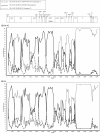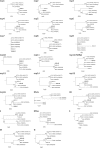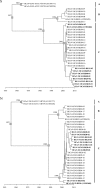Molecular epidemiology of human coronavirus OC43 reveals evolution of different genotypes over time and recent emergence of a novel genotype due to natural recombination
- PMID: 21849456
- PMCID: PMC3194943
- DOI: 10.1128/JVI.05512-11
Molecular epidemiology of human coronavirus OC43 reveals evolution of different genotypes over time and recent emergence of a novel genotype due to natural recombination
Abstract
Although human coronavirus OC43-OC43 (HCoV-OC43) is the coronavirus most commonly associated with human infections, little is known about its molecular epidemiology and evolution. We conducted a molecular epidemiology study to investigate different genotypes and potential recombination in HCoV-OC43. Twenty-nine HCoV-OC43 strains from nasopharyngeal aspirates, collected from 2004 to 2011, were subjected to RNA-dependent RNA polymerase (RdRp), spike, and nucleocapsid gene analysis. Phylogenetic analysis showed at least three distinct clusters of HCoV-OC43, although 10 unusual strains displayed incongruent phylogenetic positions between RdRp and spike genes. This suggested the presence of four HCoV-OC43 genotypes (A to D), with genotype D most likely arising from recombination. The complete genome sequencing of two genotype C and D strains and bootscan analysis showed recombination events between genotypes B and C in the generation of genotype D. Of the 29 strains, none belonged to the more ancient genotype A, 5 from 2004 belonged to genotype B, 15 from 2004 to 2006 belonged to genotype C, and 1 from 2004 and all 8 from 2008 to 2011 belonged to the recombinant genotype D. Molecular clock analysis using spike and nucleocapsid genes dated the most recent common ancestor of all genotypes to the 1950s, genotype B and C to the 1980s, genotype B to the 1990s, and genotype C to the late 1990s to early 2000s, while the recombinant genotype D strains were detected as early as 2004. This represents the first study to describe natural recombination in HCoV-OC43 and the evolution of different genotypes over time, leading to the emergence of novel genotype D, which is associated with pneumonia in our elderly population.
Figures





Similar articles
-
Genotype shift in human coronavirus OC43 and emergence of a novel genotype by natural recombination.J Infect. 2015 Jun;70(6):641-50. doi: 10.1016/j.jinf.2014.12.005. Epub 2014 Dec 18. J Infect. 2015. PMID: 25530469 Free PMC article.
-
Identification and evolutionary dynamics of two novel human coronavirus OC43 genotypes associated with acute respiratory infections: phylogenetic, spatiotemporal and transmission network analyses.Emerg Microbes Infect. 2017 Jan 4;6(1):e3. doi: 10.1038/emi.2016.132. Emerg Microbes Infect. 2017. PMID: 28050020 Free PMC article.
-
Molecular epidemiology and evolutionary histories of human coronavirus OC43 and HKU1 among patients with upper respiratory tract infections in Kuala Lumpur, Malaysia.Virol J. 2016 Feb 25;13:33. doi: 10.1186/s12985-016-0488-4. Virol J. 2016. PMID: 26916286 Free PMC article.
-
Properties of Coronavirus and SARS-CoV-2.Malays J Pathol. 2020 Apr;42(1):3-11. Malays J Pathol. 2020. PMID: 32342926 Review.
-
Candidate historical events for the emergence of Human Coronavirus OC43: A critical reassessment of the molecular evidence.PLoS One. 2023 May 8;18(5):e0285481. doi: 10.1371/journal.pone.0285481. eCollection 2023. PLoS One. 2023. PMID: 37155606 Free PMC article. Review.
Cited by
-
Cellular dynamics shape recombination frequency in coronaviruses.PLoS Pathog. 2024 Sep 27;20(9):e1012596. doi: 10.1371/journal.ppat.1012596. eCollection 2024 Sep. PLoS Pathog. 2024. PMID: 39331680 Free PMC article.
-
Unveiling viral pathogens in acute respiratory disease: Insights from viral metagenomics in patients from the State of Alagoas, Brazil.PLoS Negl Trop Dis. 2024 Sep 23;18(9):e0012536. doi: 10.1371/journal.pntd.0012536. eCollection 2024 Sep. PLoS Negl Trop Dis. 2024. PMID: 39312587 Free PMC article.
-
Anti-RBD IgG antibodies from endemic coronaviruses do not protect against the acquisition of SARS-CoV-2 infection among exposed uninfected individuals.Front Immunol. 2024 May 23;15:1396603. doi: 10.3389/fimmu.2024.1396603. eCollection 2024. Front Immunol. 2024. PMID: 38846944 Free PMC article.
-
Genetic Diversity and Detection of Respiratory Viruses Excluding SARS-CoV-2 during the COVID-19 Pandemic in Gabon, 2020-2021.Viruses. 2024 Apr 28;16(5):698. doi: 10.3390/v16050698. Viruses. 2024. PMID: 38793579 Free PMC article.
-
Structural understanding of SARS-CoV-2 virus entry to host cells.Front Mol Biosci. 2023 Nov 2;10:1288686. doi: 10.3389/fmolb.2023.1288686. eCollection 2023. Front Mol Biosci. 2023. PMID: 38033388 Free PMC article. Review.
References
Publication types
MeSH terms
Substances
Associated data
- Actions
- Actions
LinkOut - more resources
Full Text Sources
Other Literature Sources
Medical
Research Materials

